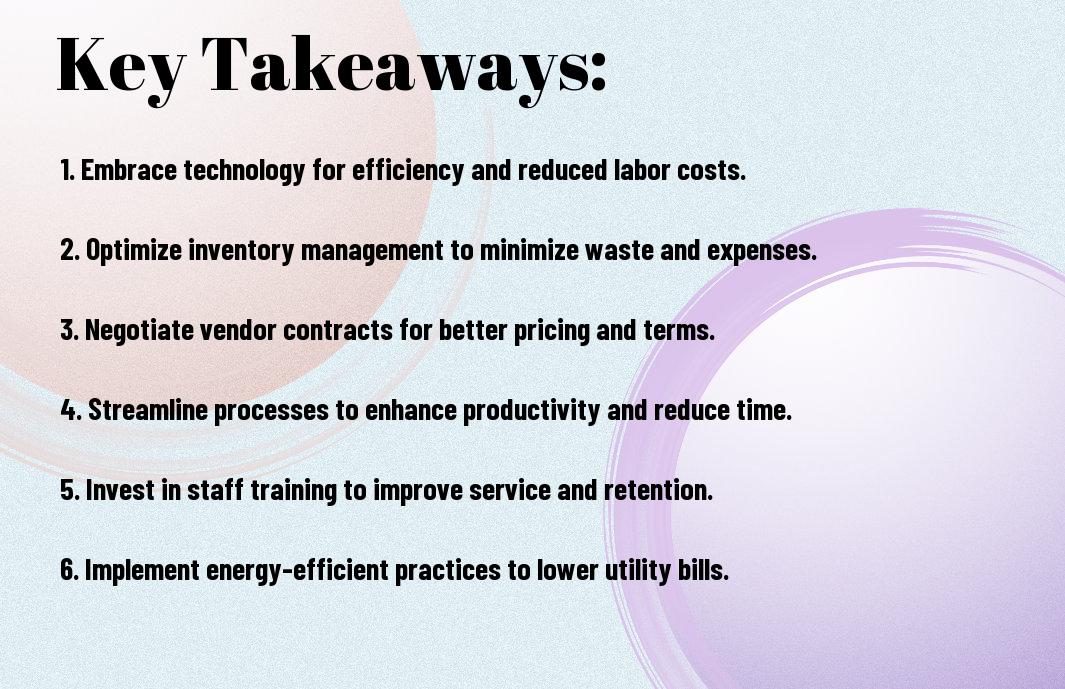Rising Costs in Dentistry – Smart Ways to Reduce Overhead Without Compromising Quality
There’s a growing concern in the dental industry about the rising costs that can strain practice finances. As I navigate these challenges, I want to share some effective strategies that can help you reduce overhead while still delivering excellent care to your patients. From streamlining operations to embracing technology, I’ll explore practical ways to enhance your practice’s efficiency without sacrificing the quality of service you provide. These insights can empower your practice to thrive in today’s competitive landscape.
Key Takeaways:
- Evaluate and optimize supply chain management to identify cost-saving opportunities while maintaining necessary inventory levels.
- Implement technology solutions, such as digital billing and scheduling, to streamline operations and enhance patient experience.
- Regularly review staffing efficiency and consider cross-training employees to reduce labor costs without sacrificing service quality.
- Negotiate with vendors for better pricing or explore alternative suppliers to lower material costs organically.
- Engage in preventive maintenance for dental equipment to avoid expensive repairs and downtime, ensuring smooth clinic operations.

Understanding Dental Practice Overhead
To effectively manage a dental practice, it’s necessary to grasp the concept of overhead. This encompasses all the costs required to run your practice, excluding the direct costs associated with providing dental services. Understanding your overhead can help you identify areas where you can cut expenses while maintaining quality care for your patients.
Common Expense Categories in Dental Practices
For dental practices, common expense categories include rent or mortgage payments, staff salaries, dental supplies, equipment maintenance, and utilities. By meticulously tracking these expenses, you can gain insights into your spending patterns and uncover potential opportunities for cost savings.
Benchmarking Your Practice’s Financial Health
Across the dental industry, benchmarking is an effective way to evaluate your practice’s financial health. By comparing key performance indicators (KPIs) with industry standards, you can gain valuable insights into how your practice stacks up against competitors and identify areas for improvement.
Practice benchmarking involves analyzing metrics such as production per hour, profit margins, and collections rates, which can highlight strengths and weaknesses in your operations. By regularly reviewing these metrics, you can spot trends that may indicate whether your overhead is becoming unsustainable or if you’re performing well. This proactive approach enables you to make informed financial decisions and implement strategies that enhance financial stability in your practice.
Staff Optimization and Management
Some practices experience rising overhead costs due to inefficiencies in staff management. By ensuring your team is utilized effectively, you can minimize waste, enhance productivity, and ultimately reduce expenses. This optimization process entails evaluating roles, improving communication, and aligning staff responsibilities with their strengths, resulting in a more cohesive and efficient work environment.
Efficient Scheduling and Productivity Metrics
Below are some strategies for enhancing your scheduling process. By implementing software tools that track appointment times and gaps in the schedule, you can identify peak hours and adjust staff coverage accordingly. Regularly reviewing productivity metrics helps you to identify bottlenecks and make data-driven decisions to improve workflow, ensuring your team remains engaged and your practice’s efficiency increases.
Training and Cross-Training for Maximum Efficiency
Below I discuss the importance of investing in employee development. When you provide comprehensive training, you not only enhance the skills of your staff but also empower them to handle various roles within the practice. This flexibility leads to a more adaptable team, capable of filling in for one another as needed, which ultimately fosters a more harmonious workplace.
And by implementing a thorough training and cross-training program, you can significantly enhance your team’s overall productivity. As staff members gain knowledge in multiple areas, it reduces the strain on individual roles and creates a more resourceful workforce. This not only improves morale but also mitigates the risk associated with turnover, as even in the absence of key staff, your practice can continue to run smoothly. Regularly updating these training programs ensures that your team remains current, allowing you to maintain the highest quality of service while controlling costs.
Technology Investments That Pay Off
Not every investment in technology leads to increased overhead. In fact, when approached wisely, strategic investments can enhance efficiency, streamline workflows, and ultimately improve patient care. By incorporating advanced tools and systems into your practice, you can significantly reduce costs while maintaining high standards of quality. Prioritizing technology that aligns with your unique practice needs can lead to substantial long-term savings.
Digital Solutions That Reduce Long-Term Costs
With the right digital solutions, your practice can achieve remarkable efficiencies that translate into lower long-term costs. Implementing tools such as electronic health records, practice management software, and digital imaging can diminish paper usage, reduce administrative burdens, and enhance communication. These innovations not only improve patient experiences but also allow you to allocate resources more effectively, leading to increased profitability over time.
Evaluating ROI on Dental Technology Purchases
By carefully assessing the return on investment (ROI) for each technology purchase, you ensure that your expenditures are yielding tangible benefits. Take the time to define meaningful metrics such as time saved, increased patient volume, and improved outcomes. This structured approach will enable you to make informed decisions that contribute to your practice’s growth and sustainability.
At the heart of evaluating ROI on dental technology purchases is a clear understanding of your practice’s financial landscape. Analyzing the impact of each investment in terms of increased efficiency and reduced costs is vital. I suggest keeping track of metrics such as patient retention rates and overhead reduction over six months to a year. This data will highlight the benefits of your investment and help guide future technology decisions. Aim for solutions that not only address current needs but also scale with your practice, ensuring that every dollar spent maximizes returns.
Supply Chain Management
All dental practices face rising costs, making effective supply chain management vital for maintaining profitability while ensuring high-quality patient care. By optimizing your supply chain processes, you can reduce waste and improve efficiency, allowing you to allocate resources more effectively and enhance your practice’s overall productivity.
Inventory Control Systems and Just-in-Time Ordering
Along with managing your supply chain, implementing an inventory control system and Just-in-Time ordering can streamline operations and minimize excess inventory. This strategy allows you to align purchases more closely with your actual usage, reducing storage costs and freeing up capital that can be invested back into your practice.
Negotiating With Vendors and Group Purchasing Options
JustinTime negotiations with vendors can lead to substantial savings and improved terms. Being proactive in discussing pricing and exploring group purchasing options can enhance your buying power and position.
Due to the competitive nature of dental supplies, negotiating effectively with vendors can yield significant savings for your practice. By establishing strong relationships and exploring group purchasing organizations (GPOs), you have the potential to secure better prices on vital items. This strategy not only enhances your financial bottom line but also ensures continuity in your supply chain, helping to maintain the quality of care you provide. Moreover, by pooling resources with other practices through GPOs, you can leverage larger buying power, optimizing your operational efficiency without sacrificing value.
Energy and Operational Efficiency
Now is the perfect time to assess your practice’s energy consumption and operational efficiency. By adopting smarter strategies, you can significantly reduce overhead expenses while maintaining the quality of care you provide. Streamlining processes and leveraging technology not only enhances productivity but also contributes to a greener footprint, promoting sustainability in dentistry.
Sustainable Practices That Cut Utility Costs
One effective way to minimize utility expenses is to implement sustainable practices such as using energy-efficient appliances and optimizing your heating and cooling systems. These upgrades can lead to substantial savings on your energy bills, all while promoting a healthier environment for your patients and staff.
Space Utilization and Equipment Maintenance
The way you utilize space in your practice, along with consistent equipment maintenance, plays a vital role in operational efficiency. Evaluating your layout can enhance workflow, reduce clutter, and improve the patient experience while ensuring your equipment is functioning optimally.
This synergy between space utilization and equipment maintenance fosters an efficient practice environment. By organizing your workspace, I find that you not only improve the patient flow but also contribute to less wear and tear on tools and machines. Regularly scheduled maintenance can prevent costly breakdowns, keeping your instruments in top condition and ensuring patient safety. Additionally, an organized environment tends to boost staff morale, translating to better patient care and increased productivity.

Marketing and Patient Retention Strategies
Many practices struggle with rising overhead costs, but effective marketing and patient retention can make a significant difference. By leveraging digital tools and fostering long-term relationships with patients, I can reinforce my practice’s reputation and keep my schedule full—ensuring that quality care remains a priority.
Cost-Effective Digital Marketing Approaches
CostEffective digital marketing strategies, such as optimizing my website for search engines and using social media platforms, can significantly boost my practice’s visibility. Engaging content, targeted ads, and local SEO will help you attract new patients without breaking the bank. By focusing on these low-cost channels, I can create a consistent online presence that drives patient inquiries and enhances overall practice growth.
Patient Loyalty Programs That Increase Case Acceptance
CostEffective patient loyalty programs offer rewards that encourage case acceptance while fostering a sense of community among my patients. These programs create incentives for patients to choose additional services, ensuring they receive the comprehensive care they deserve.
But I need to design my loyalty program thoughtfully to maximize its effectiveness. Offering rewards—like discounts on future treatments or referral bonuses—can not only improve patient retention but also increase case acceptance rates. Additionally, recognizing and rewarding long-term patients fosters a stronger relationship and increases patient satisfaction. Ultimately, a well-structured program can significantly enhance my practice’s profitability while ensuring patients feel valued and motivated to pursue the best care options available.
Summing up
Taking this into account, I believe that by strategically evaluating your practice operations, you can effectively reduce overhead without sacrificing the quality of care you provide. Emphasizing efficiency in supply use, investing in technology that streamlines processes, and fostering strong supplier relationships can lead to substantial savings. You can create a more sustainable practice while maintaining your commitment to excellent patient outcomes. Being proactive in these areas positions your practice for success in an increasingly challenging dental landscape.
FAQ
Q: What are the primary factors contributing to rising costs in dentistry?
A: Rising costs in dentistry can be attributed to several factors, including increased labor expenses, rising material costs, regulatory compliance, advanced technology investments, and inflation. Additionally, overhead expenses like rent, utilities, and insurance can significantly impact overall costs.
Q: How can dental practices streamline their operations to reduce overhead?
A: Practices can streamline operations by implementing efficient scheduling systems, utilizing digital patient management tools, and optimizing staff roles. Regularly reviewing workflows and eliminating unnecessary processes can help minimize wasted time and resources, ultimately reducing costs.
Q: What role does technology play in managing overhead in dental practices?
A: Technology can enhance productivity and efficiency, which in turn can reduce overhead costs. By adopting digital solutions like electronic health records (EHR), automated billing systems, and tele-dentistry, practices can save on administrative costs and improve patient engagement.
Q: Are there cost-effective methods to source dental materials without sacrificing quality?
A: Yes, practices can consider bulk purchasing, establishing relationships with multiple suppliers, or looking for local manufacturers to reduce shipping costs. Exploring generic options for materials or negotiating better rates with suppliers can also contribute to cost savings.
Q: How can dental practices decrease labor costs while maintaining service quality?
A: To decrease labor costs, practices can cross-train staff to handle multiple roles, embrace flexible scheduling, and utilize part-time employees during peak demand times. Implementing performance incentives can also enhance employee productivity, ensuring quality service at lower costs.
Q: What strategies can be employed to improve patient retention and reduce marketing expenses?
A: Enhancing patient relationships through exceptional service, follow-up appointments, and personalized communication can significantly improve retention. Word-of-mouth referrals and leveraging social media for low-cost marketing can also help maintain a steady patient base without hefty expenditures.
Q: How can dental practices maximize their profitability while ensuring quality care?
A: Practices can maximize profitability by assessing service pricing, offering preventive care packages, and ensuring insurance claims are processed efficiently. Maintaining high standards of care while being open to innovative service models, like subscription-based care, can attract new patients and ensure long-term success.




